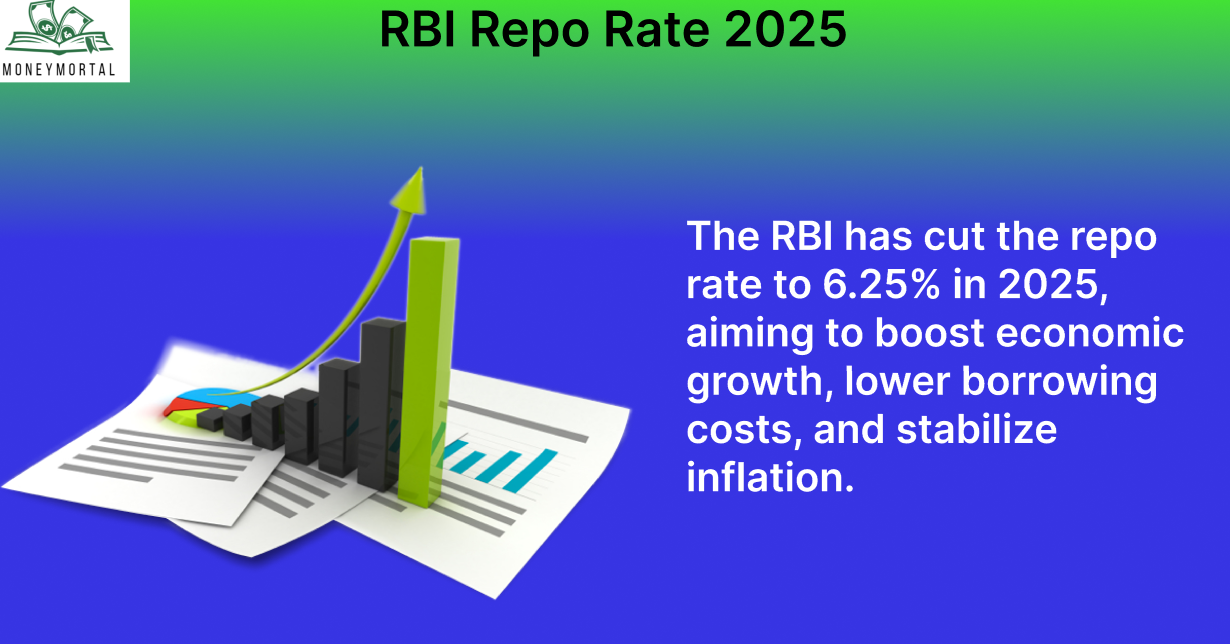In this blog post, we cover comprehensive information on the RBI Repo Rate 2025. Key aspects include its impact on the economy, insights into the reasons behind rate changes, and future outlooks. These points are critical for learners and investors to understand the dynamics of monetary policy and its implications on personal finance and the broader economy. The RBI has cut the repo rate to 6.25% in 2025, aiming to boost economic growth, lower borrowing costs, and stabilize inflation.
RBI Cuts Repo Rate in 2025
Understanding the repo rate is essential for anyone involved in finance or economics. The repo rate not only influences the borrowing costs for banks but also indirectly affects the loans and deposits offered by financial institutions to the public.
This cut is particularly significant as it comes at a time when many economies are facing headwinds. Given the context of a post-pandemic recovery, this proactive measure by the RBI indicates a responsive approach to current economic challenges.
The Reserve Bank of India (RBI) has announced a repo rate cut of 25 basis points, bringing it down to 6.25%. This marks the first reduction in nearly five years, aimed at stimulating economic growth while keeping inflation under control.
What is the Repo Rate?
The repo rate is the interest rate at which the RBI lends money to commercial banks. When the repo rate is reduced, borrowing costs for businesses and consumers decrease, leading to higher investments and spending. Additionally, it affects the interest rates on savings accounts and fixed deposits that consumers hold, making it a crucial factor in personal finance.
Why Did RBI Reduce the Repo Rate in 2025?
This decline in inflation is attributed to various factors, including reduced food prices and effective government policies aimed at stabilizing the economy. The RBI’s inflation target is set taking into account various economic indicators, and achieving this target is paramount for sustainable economic growth.
1. Declining Inflation
Furthermore, with the implementation of the Goods and Services Tax (GST) and other economic reforms, the RBI aims to create an environment conducive to growth. A repo rate cut is a tool to encourage spending during periods of low demand.
India’s inflation rate has been gradually declining, reaching a four-month low of 5.22% in December. The RBI projects an average inflation rate of 4.8% for 2025 and 4.2% for 2026, making room for an interest rate cut.
Global economic conditions, including trade tensions and fluctuating commodity prices, also play a role in influencing the RBI’s decisions. This interconnectedness means that local policies must be adaptable to international developments.
2. Boosting Economic Growth
India’s GDP growth rate is projected at 6.4% for the current fiscal year, with estimates ranging between 6.3% and 6.8% for the next year. Lowering the repo rate is expected to stimulate demand, encourage business expansion, and attract more investments.
3. Global Economic Conditions
With global economic uncertainties and slowing international trade, central banks worldwide are adopting monetary easing policies. India’s move aligns with this trend to ensure stability and sustained growth.
Such positive stock market reactions not only boost investor confidence but also lead to greater wealth creation for individuals and institutions involved in stock trading. This wealth effect can stimulate spending in the economy.
How the Repo Rate Cut Impacts You
Increased access to capital can lead to innovation and expansion in various sectors. Many entrepreneurs might find this an opportune moment to launch new ventures or enhance existing operations, which is crucial for job creation.
A reduction in the repo rate leads to lower home loan interest rates. Homebuyers and property investors can expect reduced EMIs, making housing more affordable. For instance, a ₹50 lakh loan over 20 years could save borrowers thousands in interest payments. This reduction encourages more people to enter the housing market, which can lead to a surge in real estate demand.
A reduction in the repo rate leads to lower home loan interest rates. Homebuyers and property investors can expect reduced EMIs, making housing more affordable. For instance, a ₹50 lakh loan over 20 years could save borrowers thousands in interest payments.
2. Stock Market Boost
With the surge in housing demand, real estate prices may stabilise or even rise as developers respond to the increased interest. This could lead to a more balanced market, benefiting both buyers and sellers.
After the RBI’s announcement, stock markets reacted positively. Nifty 50 and BSE Sensex witnessed gains, with rate-sensitive sectors like banking, real estate, and automobiles experiencing a surge.
3. Improved Business Lending
The RBI’s actions are crucial in maintaining economic stability. Stakeholders are advised to stay informed and adapt their strategies in response to the ever-evolving financial landscape.
With cheaper loans, businesses can expand operations, hire more employees, and increase productivity. Small and medium enterprises (SMEs) stand to benefit the most from reduced financing costs.
Expert Opinions on the RBI Rate Cut
Banking Sector Response
Financial analysts believe that while the rate cut is a positive move, additional measures like better liquidity management are required to encourage lending and credit flow. They also stress the importance of maintaining investor confidence in light of changing economic conditions.
Real Estate Growth
Developers and property experts anticipate an increase in housing demand, as home loans become more affordable.
What’s Next for RBI’s Monetary Policy?
The RBI has adopted a neutral stance, indicating that future rate changes will depend on inflation trends and economic performance. Governor Sanjay Malhotra emphasized the importance of continuous monitoring of liquidity and inflationary pressures.
Final Thoughts: What Should You Do Now?
- Homebuyers: Consider locking in a low-interest home loan to take advantage of cheaper borrowing costs.
- Investors: Look at rate-sensitive sectors like banking, real estate, and auto for potential market gains.
- Business Owners: This is a great time to expand operations with lower financing costs.
Stay Updated With the Latest Financial Trends!
For more updates on RBI policies, economic trends, and investment opportunities, subscribe to our MONEYMORTAL and follow our blog! Staying informed will empower you to make better financial decisions and seize opportunities in the market.

